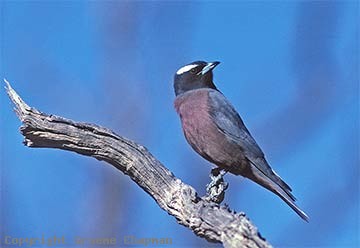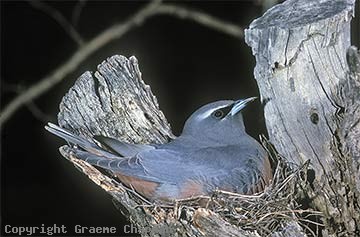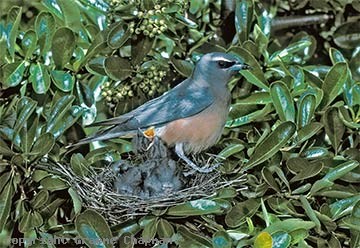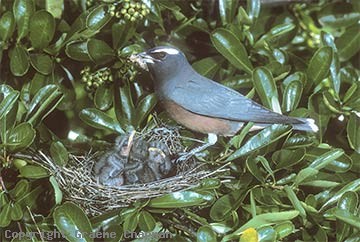Australian Birds
White-browed Woodswallow
Artamus superciliosus
(Viewing 4 of 12 photos)
|
The arrival of the migratory woodswallows in southern Australia usually coincides with a spell of warmer weather and signals that summer is on its way! The distinctive sound of hundreds (sometimes thousands) of birds high overhead is an annual event in the southern inland and in some dry years may even extend to some coastal regions. White-browed and Masked Woodswallows make up these flocks and like most of our migrants, they seek out country in good condition to settle down and breed.
When nesting, flocks form rather loose-knit colonies, the nests usually spaced approx. 20-50 metres apart in the forks of trees and shrubs although occasionally I have seen two nests in the same tree - sometimes they are quite low, even a metre or so of the ground. Aerial acrobats, they feed on flying insects, often high in the air but will also descend to feed on the ground amongst flowering annuals or even on emerging termites. They also feed on the sugary parts of lerps amongst tree foliage and are fond of the nectar of flowering eremophilas and eucalypts, particularly bloodwoods. To this end they have slightly brush-tipped tongues, like the honeyeaters.
Unlike the three "dark" woodswallows that habitually roost at night in a bee-swarm-like cluster, both Masked and White-browed Woodswallows roost mainly singly by pressing themselves vertically into nooks and crevices in tree branches. There are one or two observations of several birds clustering together but this is unusual. One of the problems is observing them at dusk when they go to roost. They are extremely sensitive to any attempts to approach them closely.
White-browed and Masked Wooswallows are very closely related. They often occur in mixed flocks and records of apparent hybrids are not uncommon. See pic #544204D. Masked Woodswallows dominate in Western Australia but in far eastern Australia, the White-browed is more common.
|

545201 ... White-browed Woodswallow, male. |

545202 ... White-browed Woodswallow, female. |
 |

545203 ... White-browed Woodswallow, female |

545204 ... White-browed Woodswallow, male |
 |
Previous 1 2 3 Next
Return to Photo Library page









